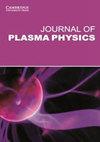Gyrokinetic moment-based simulations of the Dimits shift
IF 2.1
3区 物理与天体物理
Q2 PHYSICS, FLUIDS & PLASMAS
引用次数: 0
Abstract
We present a convergence study of the gyromoment (GM) approach, which is based on projecting the gyrokinetic distribution function onto a Hermite–Laguerre polynomial basis, focused on the cyclone base case (CBC) (Lin基于陀螺动量的迪米兹位移模拟
我们介绍了陀螺动量(GM)方法的收敛性研究,该方法基于将陀螺动量分布函数投影到 Hermite-Laguerre 多项式基础上,重点以气旋基本情况(CBC)(Lin 等人,《物理评论快报》,第 83 卷,第 18 期,1999 年,第 3645-3648 页)和 Dimits 移位(Dimits 等人,《物理等离子体》,第 7 卷,第 3 期,2000 年,第 969-983 页)为基准。我们报告说,与连续 GENE 代码(Jenko 等人,《物理等离子体》,第 7 卷,第 5 期,2000 年,第 1904-1910 页)相比,在捕捉 CBC 的非线性动力学方面,GM 方法在比较代表速度空间的点数时收敛得更快。增加速度耗散可以改善 GM 方法的收敛特性,尽管产生的饱和热通量稍大。通过改变温度平衡梯度,我们发现 GM 方法成功地再现了 Dimits 漂移(Dimits 等人,《物理等离子体》,第 7 卷第 3 期,2000 年,第 969-983 页),并有效地捕捉到了其宽度,这与陀螺流体框架形成了鲜明对比。在碰撞机制中,GM 方法的收敛特性有所改善,并与之前的全局粒子-胞内输运结果取得了良好的一致(Lin 等,《物理评论快报》,第 83 卷,第 18 期,1999 年,第 3645-3648 页)。最后,我们报告说,碰撞模型的选择对离子温度梯度增长率和非线性饱和热通量的影响很小,碰撞度与托卡马克有关。
本文章由计算机程序翻译,如有差异,请以英文原文为准。
求助全文
约1分钟内获得全文
求助全文
来源期刊

Journal of Plasma Physics
物理-物理:流体与等离子体
CiteScore
3.50
自引率
16.00%
发文量
106
审稿时长
6-12 weeks
期刊介绍:
JPP aspires to be the intellectual home of those who think of plasma physics as a fundamental discipline. The journal focuses on publishing research on laboratory plasmas (including magnetically confined and inertial fusion plasmas), space physics and plasma astrophysics that takes advantage of the rapid ongoing progress in instrumentation and computing to advance fundamental understanding of multiscale plasma physics. The Journal welcomes submissions of analytical, numerical, observational and experimental work: both original research and tutorial- or review-style papers, as well as proposals for its Lecture Notes series.
 求助内容:
求助内容: 应助结果提醒方式:
应助结果提醒方式:


